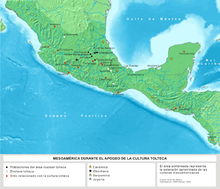
Back Tolteke Afrikaans Tolteken ALS تولتك Arabic Cultura tolteca AST Tolteca AVK Toltek mədəniyyəti Azerbaijani Toltekn BAR Тальтэкі Byelorussian Толтеки Bulgarian Tolteked Breton
 Distribution and influence of the Toltecs in Mesoamerica. | |
| Race | Coyotlatelcas, Chichimeca, Nahuas, Nonoalcas |
|---|---|
| Religion | Toltec Religion |
| Language | Nahuatl, Otomi |
| Geographical range | Mesoamerica (historically) |
| Period | Mesoamerican Postclassic Period |
| Dates | c. 950–1168 |
| Major sites | |
| Preceded by | |
| Followed by | League of Mayapan, Totonacapan, Azcapotzalco, |
| Cause of collapse | Arrival of Chichimec peoples who conquered Tula |

The Toltec culture (/ˈtɒltɛk/) was a pre-Columbian Mesoamerican culture that ruled a state centered in Tula, Hidalgo, Mexico, during the Epiclassic and the early Post-Classic period of Mesoamerican chronology, reaching prominence from 950 to 1150 CE.[1] The later Aztec culture considered the Toltec to be their intellectual and cultural predecessors and described Toltec culture emanating from Tōllān [ˈtoːlːãːn̥] (Nahuatl for Tula) as the epitome of civilization.[2] In the Nahuatl language the word Tōltēkatl [toːɬˈteːkat͡ɬ] (singular) or Tōltēkah [toːɬˈteːkaḁ] (plural) came to take on the meaning "artisan".[3] The Aztec oral and pictographic tradition also described the history of the Toltec Empire, giving lists of rulers and their exploits.
Modern scholars debate whether the Aztec narratives of Toltec history should be given credence as descriptions of actual historical events. While all scholars acknowledge that there is a large mythological part of the narrative, some maintain that, by using a critical comparative method, some level of historicity can be salvaged from the sources. Others maintain that continued analysis of the narratives as sources of factual history is futile and hinders access to learning about the culture of Tula.
Other controversies relating to the Toltec include the question of how best to understand the reasons behind the perceived similarities in architecture and iconography between the archaeological site of Tula and the Maya site of Chichén Itzá. Researchers are yet to reach a consensus in regards to the degree or direction of influence between these two sites.[4]
- ^ Smith, Michael Ernest (2012). The Aztecs (3rd ed.). Chichester, West Sussex: Wiley-Blackwell. pp. 35–36. ISBN 978-1-4051-9497-6. OCLC 741355736.
- ^ Iverson (2017).
- ^ Berit (2015), p. [page needed].
- ^ Smith (2007), p. [page needed].
© MMXXIII Rich X Search. We shall prevail. All rights reserved. Rich X Search